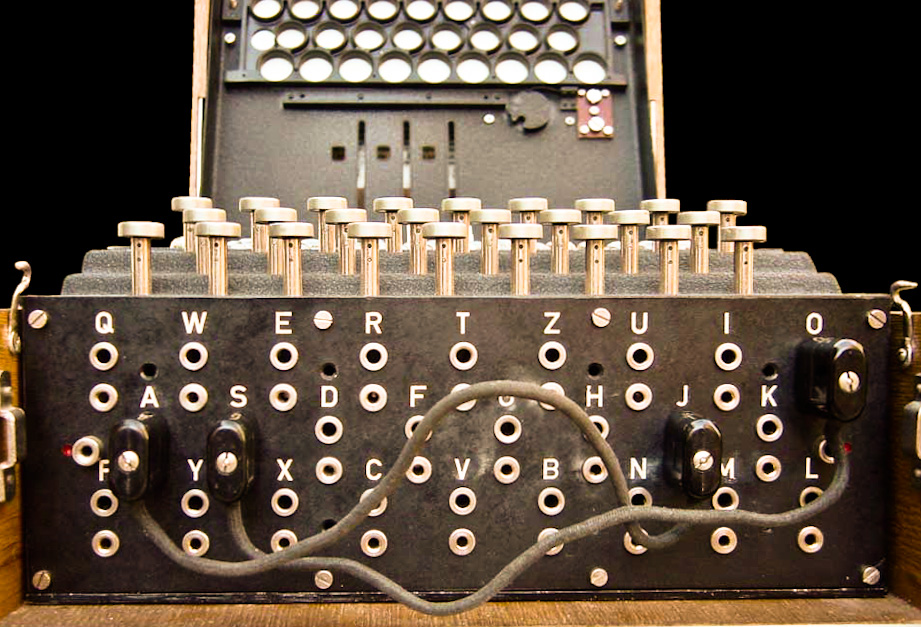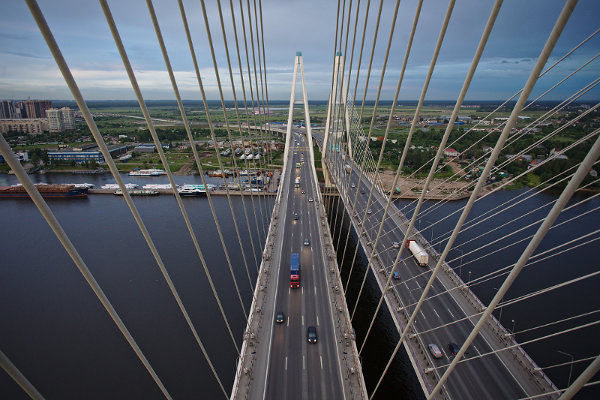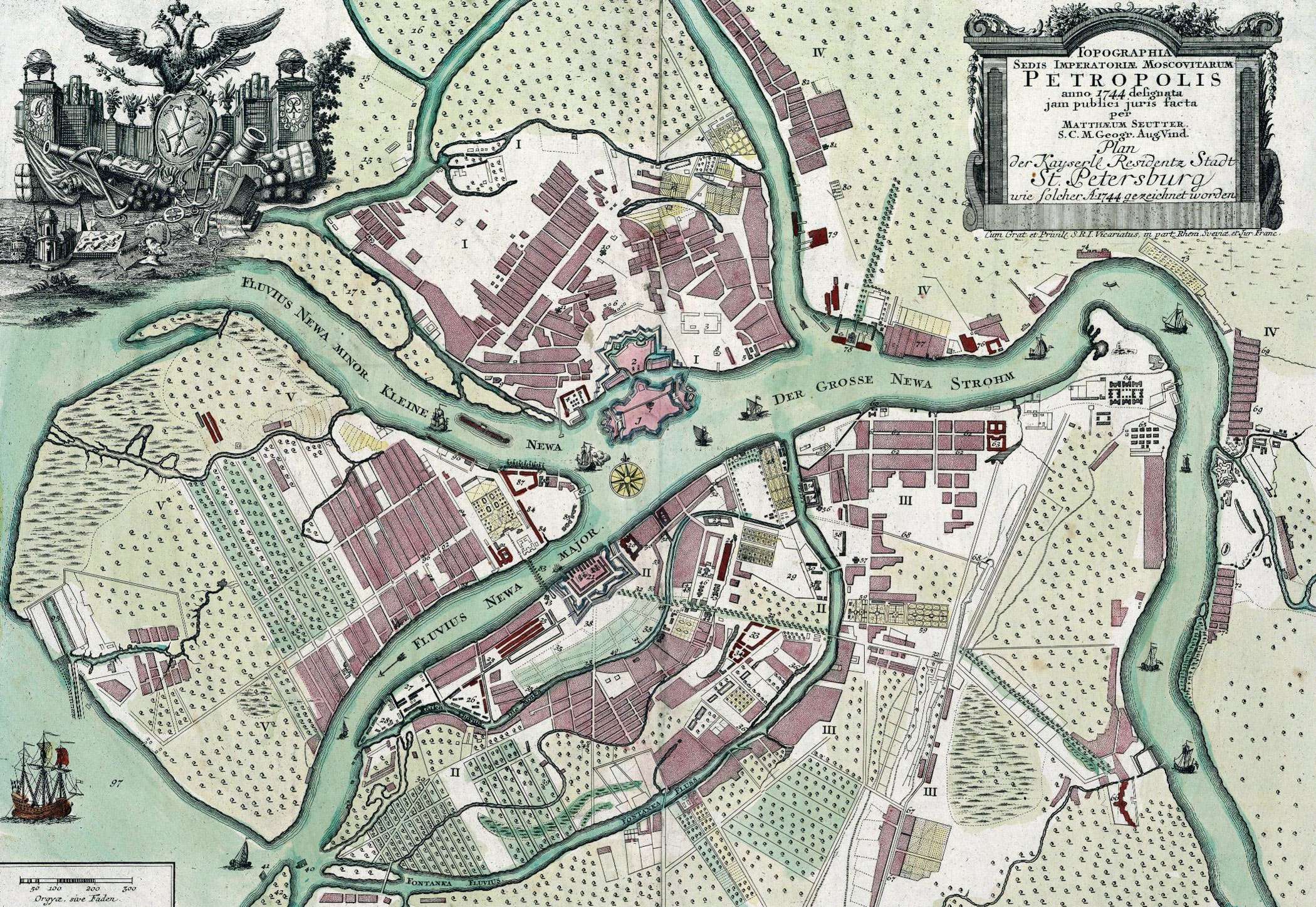|
Volodarsky Bridge
The Volodarsky Bridge () is a moveable bridge across the Neva River in Saint Petersburg, Russia. The bridge connects Narodnaya and Ivanovskaya streets (Nevsky district). It is named after V. Volodarsky, a revolutionary, who was killed near the future bridge in 1918. It is the only bridge in the city with an overpass for trams (left bank). The bridge is part of the Central Arc Thoroughfare. In 1932-1936, according to engineer G.P. Peredery's project, a three-span reinforced concrete arch bridge with a metal double-winged drawbridge was built. In 1986-1993, the old bridge was dismantled and replaced with a metal girder. The bridge length is 332 meters, the width is 24–27 meters. Upstream is the Bolshoy Obukhovsky Bridge, and below is the Finland Railway Bridge. 1936 Bridge Design The need to build a permanent bridge in this place was called by the city planning project of Leningrad in the 1930s, which provided for the significant development of its southeastern part and t ... [...More Info...] [...Related Items...] OR: [Wikipedia] [Google] [Baidu] |
Neva River
The Neva (russian: Нева́, ) is a river in northwestern Russia flowing from Lake Ladoga through the western part of Leningrad Oblast (historical region of Ingria) to the Neva Bay of the Gulf of Finland. Despite its modest length of , it is the fourth-largest river in Europe in terms of average discharge (after the Volga, the Danube and the Rhine). The Neva is the only river flowing from Lake Ladoga. It flows through the city of Saint Petersburg, the three smaller towns of Shlisselburg, Kirovsk and Otradnoye, and dozens of settlements. It is navigable throughout and is part of the Volga–Baltic Waterway and White Sea–Baltic Canal. It is the site of many major historical events, including the Battle of the Neva in 1240 which gave Alexander Nevsky his name, the founding of Saint Petersburg in 1703, and the Siege of Leningrad by the German army during World War II. The river played a vital role in trade between Byzantium and Scandinavia. Etymology The earliest people i ... [...More Info...] [...Related Items...] OR: [Wikipedia] [Google] [Baidu] |
1932
Events January * January 4 – The British authorities in India arrest and intern Mahatma Gandhi and Vallabhbhai Patel. * January 9 – Sakuradamon Incident (1932), Sakuradamon Incident: Korean nationalist Lee Bong-chang fails in his effort to assassinate Emperor Hirohito of Japan. The Kuomintang's official newspaper runs an editorial expressing regret that the attempt failed, which is used by the Japanese as a pretext to attack Shanghai later in the month. * January 22 – The 1932 Salvadoran peasant uprising begins; it is suppressed by the government of Maximiliano Hernández Martínez. * January 24 – Marshal Pietro Badoglio declares the end of Libyan resistance. * January 26 – British submarine sinks with all 60 hands. * January 28 – January 28 incident: Conflict between Japan and China in Shanghai. * January 31 – Japanese warships arrive in Nanking. February * February 2 ** A general World Disarmament Conference begins in Geneva. The principal issue at the co ... [...More Info...] [...Related Items...] OR: [Wikipedia] [Google] [Baidu] |
Bridges In Saint Petersburg
There are more than 342 bridges in the city limits of Saint Petersburg, Russia. This is a partial list of the most famous ones. Peter the Great was designing the city as another Amsterdam and Venice, with canals instead of streets and citizens skillful in sailing. Initially, there were only about ten bridges constructed in the city, mainly across ditches and minor creeks. By Peter's plans, in the summer months, the citizens were supposed to move around in boats, and in the winter months when the water froze to move in sledges. However, after Peter's death, new bridges were built, as it was a much easier way of transportation. Temporary ponton bridges were used in the summertime. The first permanent bridge of bricks and stones across the main branch of the Neva river appeared in 1850. Today, there are more 342 bridges over canals and rivers of various sizes, styles and constructions, built at different periods. Some of them are small pedestrian bridges, such as Bank and Lion bridge ... [...More Info...] [...Related Items...] OR: [Wikipedia] [Google] [Baidu] |
Big Obukhovsky Bridge
The Big Obukhovo Bridge (russian: Большо́й Обу́ховский мост, ''Boĺšoj obuhovskij most'') is the newest (not taking into account the Blagoveshchensky Bridge rebuilt in 2007) bridge across the Neva River in Saint Petersburg, Russia. It is the only bridge across the Neva which is not a drawbridge. One of the longest bridges in Russia, it is the first fixed bridge and largest bridge across the Neva. Of course it is the largest bridge in St. Petersburg by the size of the covered span (382 m). It is located in Nevsky District, in the middle stream of the Neva. It connects Obukhovskaya Oborony Avenue with the Oktyabrskaya embankment. It is a cable-stayed bridge; the steel wire ropes are the key element of the supporting construction. But what looks like a bridge is actually two identical twin bridges with opposite directions of movement along them. One is located upstream of the Neva (southern) and is for driving eastward, the other downstream (north) is for dri ... [...More Info...] [...Related Items...] OR: [Wikipedia] [Google] [Baidu] |
List Of Bridges In Saint Petersburg
There are more than 342 bridges in the city limits of Saint Petersburg, Russia. This is a partial list of the most famous ones. Peter the Great was designing the city as another Amsterdam and Venice, with canals instead of streets and citizens skillful in sailing. Initially, there were only about ten bridges constructed in the city, mainly across ditches and minor creeks. By Peter's plans, in the summer months, the citizens were supposed to move around in boats, and in the winter months when the water froze to move in sledges. However, after Peter's death, new bridges were built, as it was a much easier way of transportation. Temporary ponton bridges were used in the summertime. The first permanent bridge of bricks and stones across the main branch of the Neva river appeared in 1850. Today, there are more 342 bridges over canals and rivers of various sizes, styles and constructions, built at different periods. Some of them are small pedestrian bridges, such as Bank and Lion bridge ... [...More Info...] [...Related Items...] OR: [Wikipedia] [Google] [Baidu] |
EPRON
EPRON, russian: Экспедиция подводных работ особого назначения (ЭПРОН) "Special Expedition for Underwater Works" —Special-Purpose Underwater Rescue Party, was a government agency of the Soviet Union to salvage valuable cargo and equipment from sunken ships and submarines. History EPRON was established on 17 December 1923 and was initially under the Joint State Political Directorate () at the Council of People's Commissars. Its first operation was treasure-hunting near Sevastopol for the wreckage of HMS Prince, a steamship sunk by a storm off Balaklava in November 1854 when it was carrying gold from Britain to pay British troops fighting in the Crimea (GBP 200,000). The project team was financed, equipped, trained and managed by Japanese diving specialists, who had become highly experienced through salvaging warships of the Russian Imperial Navy sunk or scuttled during the 1904–1905 Russo-Japanese War. The wreckage was allegedly lo ... [...More Info...] [...Related Items...] OR: [Wikipedia] [Google] [Baidu] |
Aleksey Krylov
, birth_date = O.S. (August 15, 1863 N.S.) , death_date = , image = Alexey Krylov 1910s.JPG , image_size = 200px , caption = Official portrait (1910) , birth_place = Alatyrsky uezd of Simbirsk Gubernia, Russian Empire , death_place = Leningrad, USSR , placeofburial = Leningrad, USSR , placeofburial_label = , allegiance = Russian Empire , branch = Imperial Russian Navy , serviceyears = 1878–1917 , rank = General of the fleet , unit = , commands = , battles = , awards = , relations = , laterwork = , signature = Signature of Aleksey Krylov.png , signature_size = 150px , signature_alt = Aleksey Nikolaevich Krylov (russian: Алексе́й Никола́евич Крыло́в; – October 26, 1945) was a Russian naval engineer, applied mathematician and memoirist. Biography Aleksey Nikolayevich Krylov was born on August 3 O.S., 1863 in Visyaga vill ... [...More Info...] [...Related Items...] OR: [Wikipedia] [Google] [Baidu] |
Tauride Garden
The Tauride Garden (russian: Таврический сад) is a park in the Tsentralny District of Saint Petersburg, Russia. It is located behind the Tauride Palace, and near the Smolny Cathedral. History The garden was laid out between 1783 and 1789. Prince Grigory Potemkin ordered his favourite architect, William Guld, to design and lay out the park. When Potemkin died in 1791, the park and palace were used by Catherine II as a residence. Afterwards it was opened to the public. In 1898, a theater was built in the park. In 1932, it was renamed the "Park of Culture and Rest of the First Five-Year Plan", commemorating the early completion of the Soviet Union's first five-year plan for the national economy. The name "Tauride Garden" was later restored. Features The park currently contains several sports areas, an ice skating rink, and an orangery. Some of these were created when the park was partially redesigned in the late 19th and early 20th centuries. Orangery The orange ... [...More Info...] [...Related Items...] OR: [Wikipedia] [Google] [Baidu] |
Gulf Of Finland
The Gulf of Finland ( fi, Suomenlahti; et, Soome laht; rus, Фи́нский зали́в, r=Finskiy zaliv, p=ˈfʲinskʲɪj zɐˈlʲif; sv, Finska viken) is the easternmost arm of the Baltic Sea. It extends between Finland to the north and Estonia to the south, to Saint Petersburg in Russia to the east, where the river Neva drains into it. Other major cities around the gulf include Helsinki and Tallinn. The eastern parts of the Gulf of Finland belong to Russia, and some of Russia's most important oil harbors are located farthest in, near Saint Petersburg (including Primorsk). As the seaway to Saint Petersburg, the Gulf of Finland has been and continues to be of considerable strategic importance to Russia. Some of the environmental problems affecting the Baltic Sea are at their most pronounced in the shallow gulf. Proposals for a tunnel through the gulf have been made. Geography The gulf has an area of . The length (from the Hanko Peninsula to Saint Petersburg) is and t ... [...More Info...] [...Related Items...] OR: [Wikipedia] [Google] [Baidu] |
Saint Petersburg
Saint Petersburg ( rus, links=no, Санкт-Петербург, a=Ru-Sankt Peterburg Leningrad Petrograd Piter.ogg, r=Sankt-Peterburg, p=ˈsankt pʲɪtʲɪrˈburk), formerly known as Petrograd (1914–1924) and later Leningrad (1924–1991), is the second-largest city in Russia. It is situated on the Neva River, at the head of the Gulf of Finland on the Baltic Sea, with a population of roughly 5.4 million residents. Saint Petersburg is the fourth-most populous city in Europe after Istanbul, Moscow and London, the most populous city on the Baltic Sea, and the world's northernmost city of more than 1 million residents. As Russia's Imperial capital, and a historically strategic port, it is governed as a federal city. The city was founded by Tsar Peter the Great on 27 May 1703 on the site of a captured Swedish fortress, and was named after apostle Saint Peter. In Russia, Saint Petersburg is historically and culturally associated with t ... [...More Info...] [...Related Items...] OR: [Wikipedia] [Google] [Baidu] |
Leningrad
Saint Petersburg ( rus, links=no, Санкт-Петербург, a=Ru-Sankt Peterburg Leningrad Petrograd Piter.ogg, r=Sankt-Peterburg, p=ˈsankt pʲɪtʲɪrˈburk), formerly known as Petrograd (1914–1924) and later Leningrad (1924–1991), is the second-largest city in Russia. It is situated on the Neva River, at the head of the Gulf of Finland on the Baltic Sea, with a population of roughly 5.4 million residents. Saint Petersburg is the fourth-most populous city in Europe after Istanbul, Moscow and London, the most populous city on the Baltic Sea, and the world's northernmost city of more than 1 million residents. As Russia's Imperial capital, and a historically strategic port, it is governed as a federal city. The city was founded by Tsar Peter the Great on 27 May 1703 on the site of a captured Swedish fortress, and was named after apostle Saint Peter. In Russia, Saint Petersburg is historically and culturally associated with ... [...More Info...] [...Related Items...] OR: [Wikipedia] [Google] [Baidu] |




